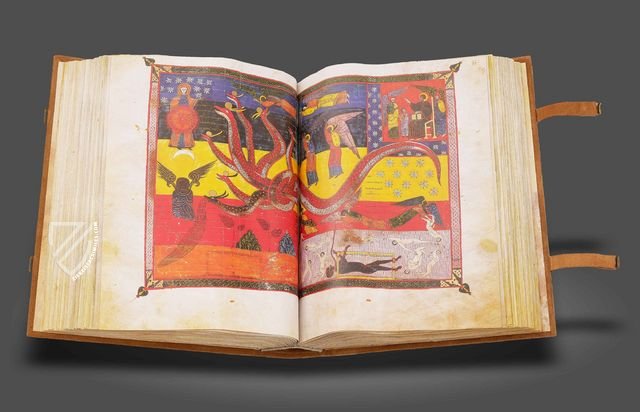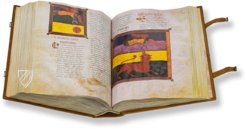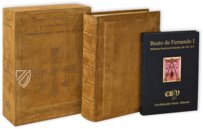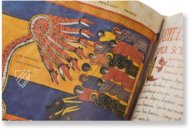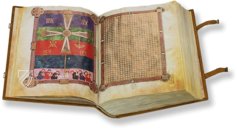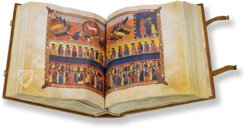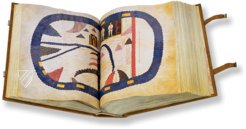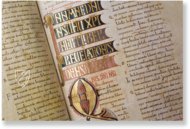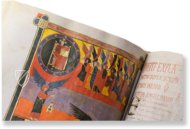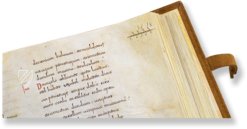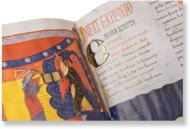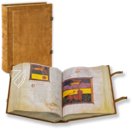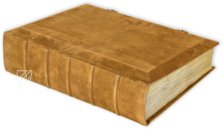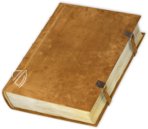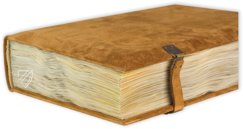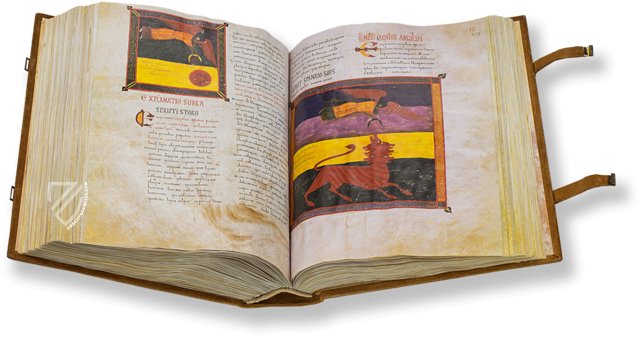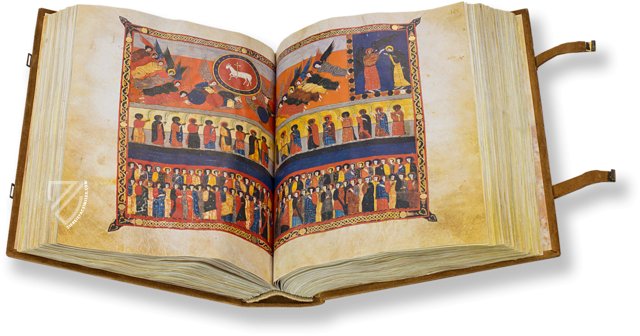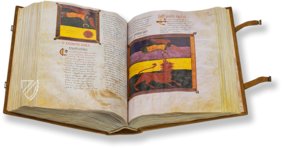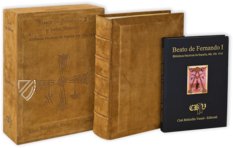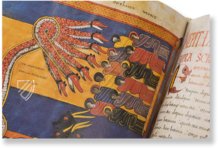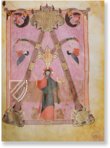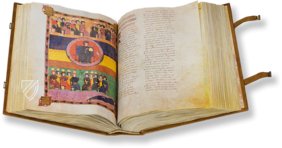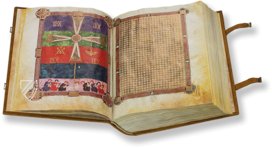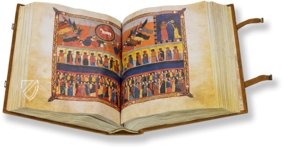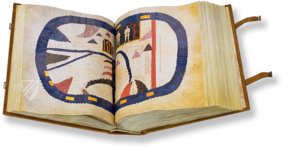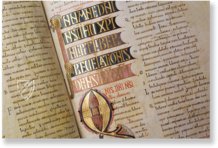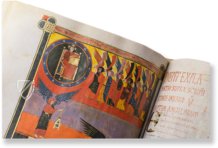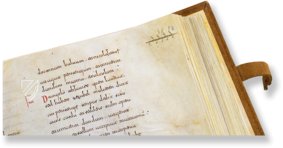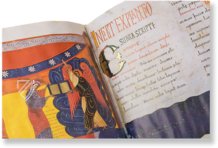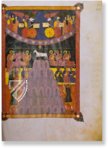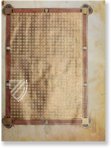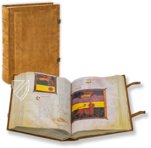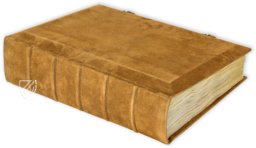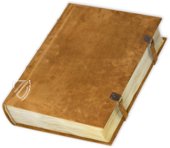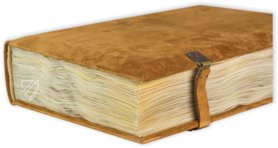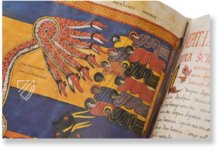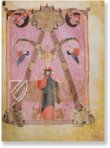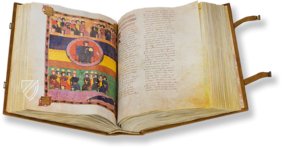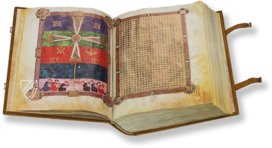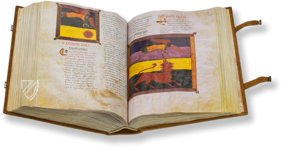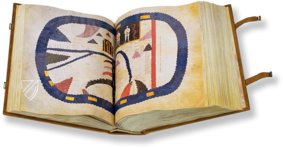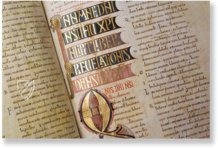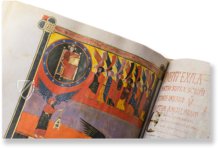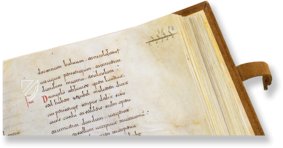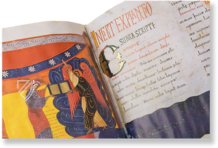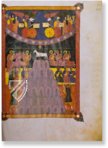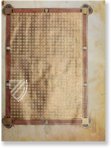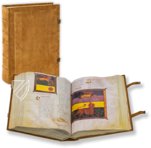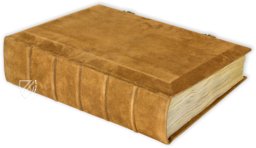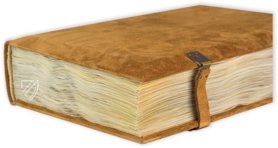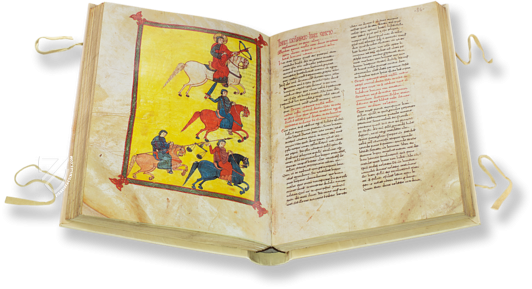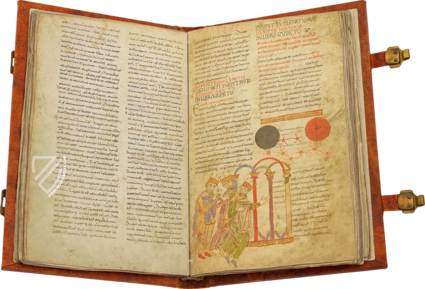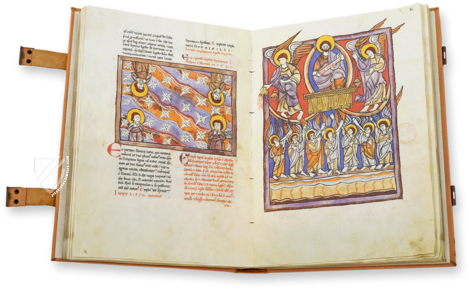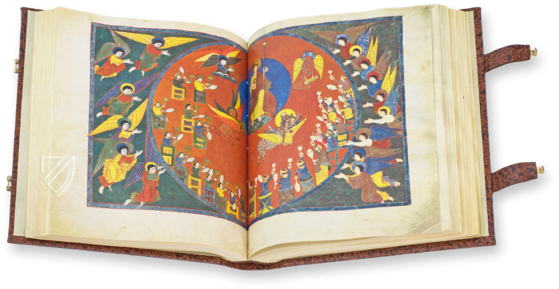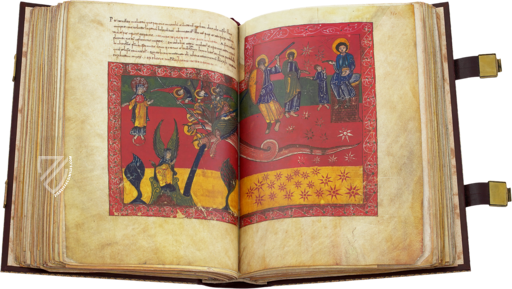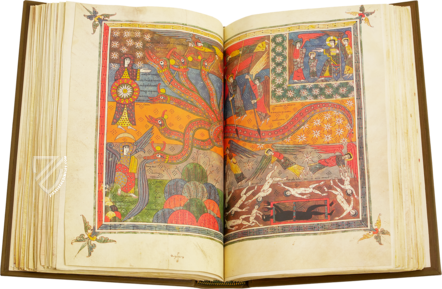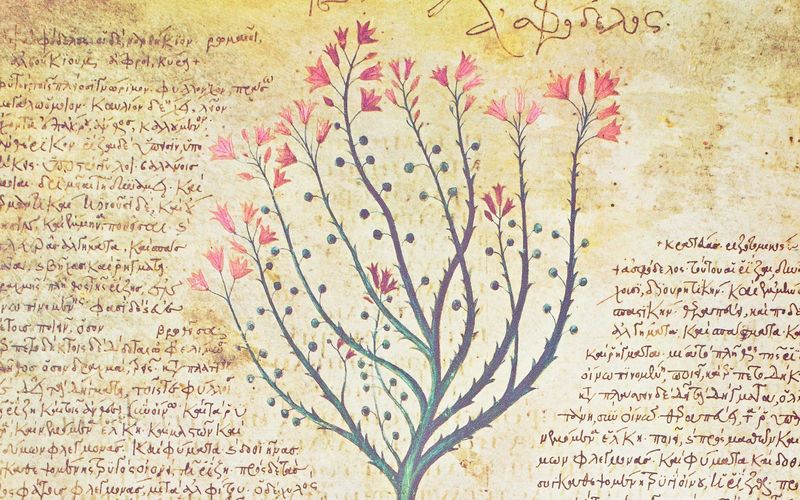Beatus of Liébana - Facundus Codex
(3,000€ - 7,000€)
The codex of King Ferdinand I and his wife Sancha is one of the most beautiful and magnificent works of the Beatus Apocalypses. It was made ca. 1047 by the scribe Facundus and is found today in the Spanish National Library. The thrilling miniatures of the codex are counted among the most beautiful illustrations of Spanish book art.
Beatus of Liébana - Facundus Codex
The Revelation of John, which is also known as the Apocalypse, is the last book of the New Testament. The story of the end of the world, of the Day of Judgement, of the descent into hell of all the sinners, has evoked great fascination from Christians of all lands for centuries. A Spanish monk by the name of Beatus composed a commentary about this book in the Bible, which has been repeatedly reproduced over several centuries. The codex of the Spanish King Ferdinand I and his wife Sancha is one of the most beautiful illuminated manuscripts of the Beatus series. The work, comprising nearly 630 pages, is adorned with 114 enthralling miniatures in excitingly luminous colors.
Who was Beatus?
Beatus of Liébana was a monk and theologian, who belonged to the Monastery of Santo Toribio de Liébana in Spain. The monk is famous above all for his magnum opus, a commentary on the biblical Apocalypse in twelve books. These twelve books originate from ca. 776 and are known today as the Beatus-Series. The twelve books were adapted into countless manuscripts, many of which survive to this day. The majority of Beatus manuscripts originate from between the 10th and 12th centuries in northern Spain. The royal codex was manufactured for Ferdinand I and his wife Sancha ca. 1047.
A Royal Masterpiece
Ferdinand I, the Great, was King of León, Castile, and Galicia from 1035 to 1065. He contributed decisively to the ascension of the Kingdom of León-Castile to the predominant power among the Christian kingdoms of Spain. King Ferdinand and Queen Sancha gave the scribe Facundus the commission to create a worthy manuscript of the Beatus Apocalypse. This book is the only one in the series that was not made in a monastery, but rather at a royal court. The valuable manuscript named by the famous author Umberto Eco as an important source of inspiration for his worldwide best-seller “The Name of the Rose”. Today it is found in the Spanish National Library.
The Most Famous Beatus Codex
The Beatus by Fecundus is often called the most magnificent of all the Beatus-codices. The travelling, dreamlike pictorial composition of the work remains forever unforgettable for each beholder. Each of the elegant miniatures shows an astounding variety of luminous, lively colors. No other Beatus-codex can come up with similarly atmospheric images. All in all, this splendid manuscript is one of the most valuable works of Spanish book art.
Codicology
- Alternative Titles
- Beato de Liébana, códice de Fernando I y doña Sancha
Beatus von Ferdinand I. und Doña Sancha
Beato di Ferdinando I e Donna Sancha
Beato de Fernando I e Dona Sancha
Béatus de Ferdinand I
Beato de Facundo
Facundus Beatus - Size / Format
- 624 pages / 36.0 × 26.8 cm
- Origin
- Spain
- Date
- Ca. 1047
- Style
- Genre
- Language
- Illustrations
- 114 miniatures
- Patron
- Ferdinand I (1015–1065), King of León and Emperor of Spain, and his wife Sancha of León
- Artist / School
- Beatus of Liébana (died after 798) (author)
Facundus (illuminator) - Previous Owners
- Philip V (1683–1746), King of Spain
Beatus of Liébana - Facundus Codex
Christ, Alpha and Omega
Standing within an Alpha initial consisting of splendid Insular interlace with animal heads incorporated into the feet, Christ is standing holding an Omega initial in one hand and making the sign of benediction in the other. This is a fine example of the increasing influence of Romanesque art in Beatus manuscripts, combining this new international style with distinctly Hiberno-Mozarabic elements, such as the unique color palette – nowhere else does one see Christ dressed in red and black.
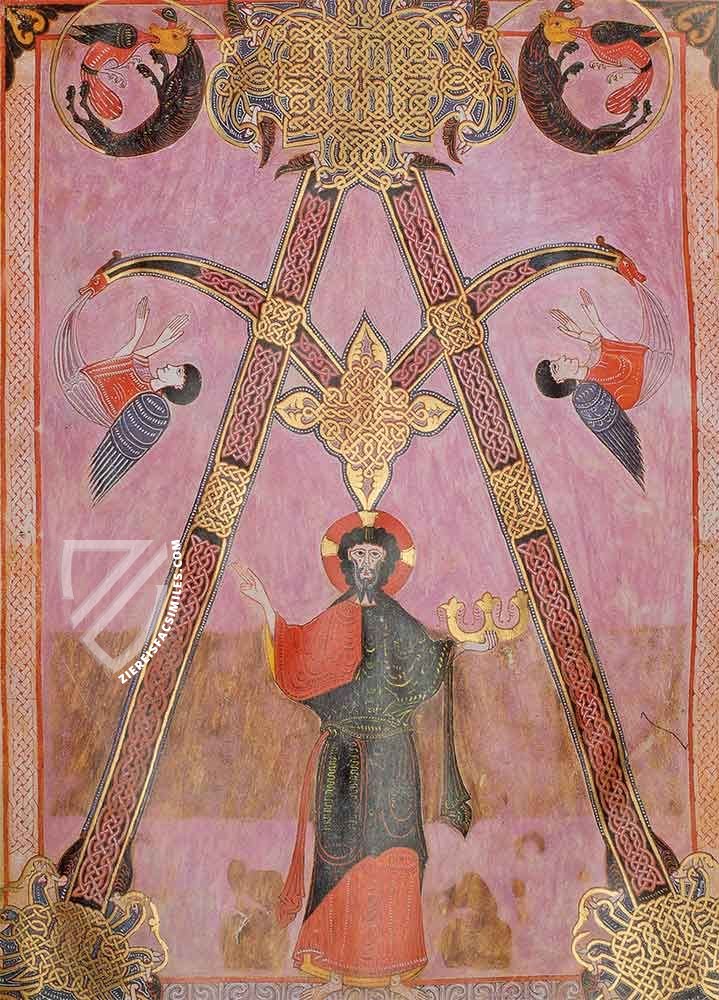
Beatus of Liébana - Facundus Codex
Vision of the Lamb on Mt. Sion
The miniatures of this manuscript are distinguished by their dark, rich color palette. The Lamb of God stands atop a purple Mt. Sion (Zion) and is accompanied by the 144,000 of the faithful who bear the name of the lamb and God upon their foreheads. They sing a song before the throne that only the faithful can know.
Although the text says that they are playing harps, the 11th century artists depict them playing something like a lute, or some other Spanish stringed instrument. The four living creatures, who appear like angels with animal heads, and numerous elders are separated from the faithful by a band of stars. They proclaim the Gospel, which they hold in their hands and is depicted in gold leaf.
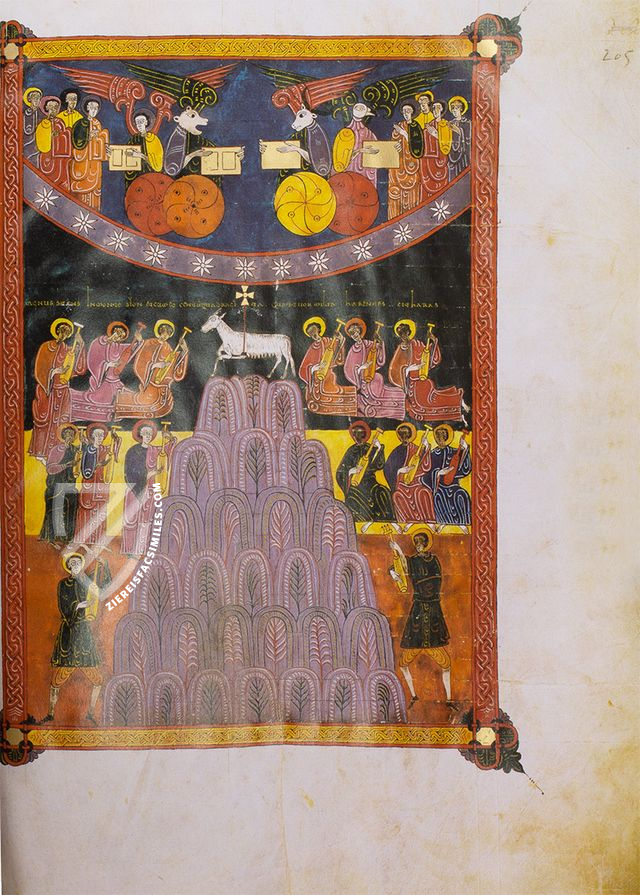
#1 Beato de Liébana, códice de Fernando I y doña Sancha
Language: Spanish
(3,000€ - 7,000€)
#2 Beato de Liébana, códice de Fernando I y doña Sancha
Languages: Spanish, English
(7,000€ - 10,000€)
- Treatises / Secular Books
- Apocalypses / Beatus
- Astronomy / Astrology
- Bestiaries
- Bibles / Gospels
- Chronicles / History / Law
- Geography / Maps
- Saints' Lives
- Islam / Oriental
- Judaism / Hebrew
- Single Leaf Collections
- Leonardo da Vinci
- Literature / Poetry
- Liturgical Manuscripts
- Medicine / Botany / Alchemy
- Music
- Mythology / Prophecies
- Psalters
- Other Religious Books
- Games / Hunting
- Private Devotion Books
- Other Genres
- Afghanistan
- Armenia
- Austria
- Belgium
- Belize
- Bosnia and Herzegovina
- China
- Colombia
- Costa Rica
- Croatia
- Cyprus
- Czech Republic
- Denmark
- Egypt
- El Salvador
- Ethiopia
- France
- Germany
- Greece
- Guatemala
- Honduras
- Hungary
- India
- Iran
- Iraq
- Israel
- Italy
- Japan
- Jordan
- Kazakhstan
- Kyrgyzstan
- Lebanon
- Liechtenstein
- Luxembourg
- Mexico
- Morocco
- Netherlands
- Palestine
- Panama
- Peru
- Poland
- Portugal
- Romania
- Russia
- Serbia
- Spain
- Sri Lanka
- Sweden
- Switzerland
- Syria
- Tajikistan
- Turkey
- Turkmenistan
- Ukraine
- United Kingdom
- United States
- Uzbekistan
- Vatican City
- A. Oosthoek, van Holkema & Warendorf
- Aboca Museum
- Ajuntament de Valencia
- Akademie Verlag
- Akademische Druck- u. Verlagsanstalt (ADEVA)
- Aldo Ausilio Editore - Bottega d’Erasmo
- Alecto Historical Editions
- Alkuin Verlag
- Almqvist & Wiksell
- Amilcare Pizzi
- Andreas & Andreas Verlagsbuchhandlung
- Archa 90
- Archiv Verlag
- Archivi Edizioni
- Arnold Verlag
- ARS
- Ars Magna
- ArtCodex
- AyN Ediciones
- Azimuth Editions
- Badenia Verlag
- Bärenreiter-Verlag
- Belser Verlag
- Belser Verlag / WK Wertkontor
- Benziger Verlag
- Bernardinum Wydawnictwo
- BiblioGemma
- Biblioteca Apostolica Vaticana (Vaticanstadt, Vaticanstadt)
- Bibliotheca Palatina Faksimile Verlag
- Bibliotheca Rara
- Boydell & Brewer
- Bramante Edizioni
- Bredius Genootschap
- Brepols Publishers
- British Library
- C. Weckesser
- Caixa Catalunya
- Canesi
- CAPSA, Ars Scriptoria
- Caratzas Brothers, Publishers
- Carus Verlag
- Casamassima Libri
- Centrum Cartographie Verlag GmbH
- Chavane Verlag
- Christian Brandstätter Verlag
- Circulo Cientifico
- Club Bibliófilo Versol
- Club du Livre
- CM Editores
- Collegium Graphicum
- Collezione Apocrifa Da Vinci
- Comissão Nacional para as Comemorações dos Descobrimentos Portugueses
- Coron Verlag
- Corvina
- CTHS
- D. S. Brewer
- Damon
- De Agostini/UTET
- De Nederlandsche Boekhandel
- De Schutter
- Deuschle & Stemmle
- Deutscher Verlag für Kunstwissenschaft
- DIAMM
- Droz
- E. Schreiber Graphische Kunstanstalten
- Ediciones Boreal
- Ediciones Grial
- Ediclube
- Edições Inapa
- Edilan
- Editalia
- Edition Deuschle
- Edition Georg Popp
- Edition Leipzig
- Edition Libri Illustri
- Editiones Reales Sitios S. L.
- Éditions de l'Oiseau Lyre
- Editions Medicina Rara
- Editorial Casariego
- Editorial Mintzoa
- Editrice Antenore
- Editrice Velar
- Edizioni Edison
- Egeria, S.L.
- Eikon Editores
- Electa
- Emery Walker Limited
- Enciclopèdia Catalana
- Eos-Verlag
- Ephesus Publishing
- Ernst Battenberg
- Eugrammia Press
- Extraordinary Editions
- Fackelverlag
- Facsimila Art & Edition
- Facsimile Editions Ltd.
- Facsimilia Art & Edition Ebert KG
- Faksimile Verlag
- Feuermann Verlag
- Folger Shakespeare Library
- Franco Cosimo Panini Editore
- Friedrich Wittig Verlag
- Fundación Hullera Vasco-Leonesa
- G. Braziller
- Gabriele Mazzotta Editore
- Gebr. Mann Verlag
- Gesellschaft für graphische Industrie
- Getty Research Institute
- Giovanni Domenico de Rossi
- Giunti Editore
- Graffiti
- Grafica European Center of Fine Arts
- Guido Pressler
- Guillermo Blazquez
- Gustav Kiepenheuer
- H. N. Abrams
- Harrassowitz
- Harvard University Press
- Helikon
- Hendrickson Publishers
- Henning Oppermann
- Herder Verlag
- Hes & De Graaf Publishers
- Hoepli
- Holbein-Verlag
- Houghton Library
- Hugo Schmidt Verlag
- Idion Verlag
- Il Bulino, edizioni d'arte
- ILte
- Imago
- Insel Verlag
- Insel-Verlag Anton Kippenberger
- Instituto de Estudios Altoaragoneses
- Instituto Nacional de Antropología e Historia
- Introligatornia Budnik Jerzy
- Istituto dell'Enciclopedia Italiana - Treccani
- Istituto Ellenico di Studi Bizantini e Postbizantini
- Istituto Geografico De Agostini
- Istituto Poligrafico e Zecca dello Stato
- Italarte Art Establishments
- Jan Thorbecke Verlag
- Johnson Reprint Corporation
- Josef Stocker
- Josef Stocker-Schmid
- Jugoslavija
- Karl W. Hiersemann
- Kasper Straube
- Kaydeda Ediciones
- Kindler Verlag / Coron Verlag
- Kodansha International Ltd.
- Konrad Kölbl Verlag
- Kurt Wolff Verlag
- La Liberia dello Stato
- La Linea Editrice
- La Meta Editore
- Lambert Schneider
- Landeskreditbank Baden-Württemberg
- Leo S. Olschki
- Les Incunables
- Liber Artis
- Library of Congress
- Libreria Musicale Italiana
- Lichtdruck
- Lito Immagine Editore
- Lumen Artis
- Lund Humphries
- M. Moleiro Editor
- Maison des Sciences de l'homme et de la société de Poitiers
- Manuscriptum
- Martinus Nijhoff
- Maruzen-Yushodo Co. Ltd.
- MASA
- Massada Publishers
- McGraw-Hill
- Metropolitan Museum of Art
- Militos
- Millennium Liber
- Müller & Schindler
- Nahar - Stavit
- Nahar and Steimatzky
- National Library of Wales
- Neri Pozza
- Nova Charta
- Oceanum Verlag
- Odeon
- Orbis Mediaevalis
- Orbis Pictus
- Österreichische Staatsdruckerei
- Oxford University Press
- Pageant Books
- Parzellers Buchverlag
- Patrimonio Ediciones
- Pattloch Verlag
- PIAF
- Pieper Verlag
- Plon-Nourrit et cie
- Poligrafiche Bolis
- Presses Universitaires de Strasbourg
- Prestel Verlag
- Princeton University Press
- Prisma Verlag
- Priuli & Verlucca, editori
- Pro Sport Verlag
- Propyläen Verlag
- Pytheas Books
- Quaternio Verlag Luzern
- Reales Sitios
- Recht-Verlag
- Reichert Verlag
- Reichsdruckerei
- Reprint Verlag
- Riehn & Reusch
- Roberto Vattori Editore
- Rosenkilde and Bagger
- Roxburghe Club
- Salerno Editrice
- Saltellus Press
- Sandoz
- Sarajevo Svjetlost
- Schöck ArtPrint Kft.
- Schulsinger Brothers
- Scolar Press
- Scrinium
- Scripta Maneant
- Scriptorium
- Shazar
- Siloé, arte y bibliofilia
- SISMEL - Edizioni del Galluzzo
- Sociedad Mexicana de Antropología
- Société des Bibliophiles & Iconophiles de Belgique
- Soncin Publishing
- Sorli Ediciones
- Stainer and Bell
- Studer
- Styria Verlag
- Sumptibus Pragopress
- Szegedi Tudomànyegyetem
- Taberna Libraria
- Tarshish Books
- Taschen
- Tempus Libri
- Testimonio Compañía Editorial
- Thames and Hudson
- The Clear Vue Publishing Partnership Limited
- The Facsimile Codex
- The Folio Society
- The Marquess of Normanby
- The Richard III and Yorkist History Trust
- Tip.Le.Co
- TouchArt
- TREC Publishing House
- TRI Publishing Co.
- Trident Editore
- Tuliba Collection
- Typis Regiae Officinae Polygraphicae
- Union Verlag Berlin
- Universidad de Granada
- University of California Press
- University of Chicago Press
- Urs Graf
- Vallecchi
- Van Wijnen
- VCH, Acta Humaniora
- VDI Verlag
- VEB Deutscher Verlag für Musik
- Verlag Anton Pustet / Andreas Verlag
- Verlag Bibliophile Drucke Josef Stocker
- Verlag der Münchner Drucke
- Verlag für Regionalgeschichte
- Verlag Styria
- Vicent Garcia Editores
- W. Turnowski Ltd.
- W. Turnowsky
- Waanders Printers
- Wiener Mechitharisten-Congregation (Wien, Österreich)
- Wissenschaftliche Buchgesellschaft
- Wissenschaftliche Verlagsgesellschaft
- Wydawnictwo Dolnoslaskie
- Xuntanza Editorial
- Zakład Narodowy
- Zollikofer AG

